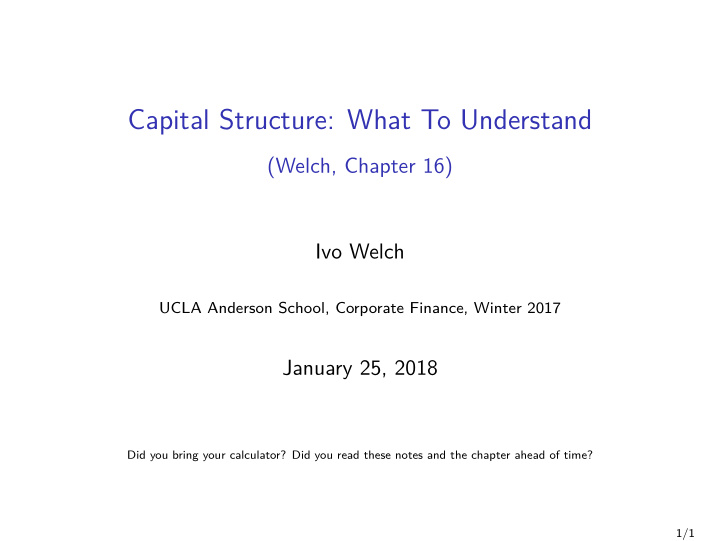



Capital Structure: What To Understand (Welch, Chapter 16) Ivo Welch UCLA Anderson School, Corporate Finance, Winter 2017 January 25, 2018 Did you bring your calculator? Did you read these notes and the chapter ahead of time? 1/1
Plan ◮ Confuse with many choices. ◮ In future sessions, learn how to think about them. Typical Board Compositions; Staggered Boards; Institutional Activism; Fiduciary Responsibility; Board and CEO Turnover. 2/1
What’s a cash flow right? What are the cash flow rights of debt and equity? 3/1
Why do any owners and managers ever return any money to funders? 4/1
What’s the diff between Straight and Convertible Debt? Is a Convertible more like Debt or more like Equity? 5/1
What’s the diff between Secured or Senior Debt and Unsecured or Subordinated Debt? 6/1
Bond Features Covenants. Seniority. Collateral. Convertibility. Puttability. Callability. Sinking Fund. Maturity. Duration. Coupon bonds. Fixed-rate vs. Floating-rate. Less so nowadays: Diffuse vs. Concentrated. Financial vs. Non-Financial. 7/1
How is/was a bank loan different from a bond? 8/1
What’s a non-financial liability (NFL) [not a term of art]? 9/1
Do NFLs provide resources to help fund the firm? 10/1
How big are NFLs usually compared to FD (Fin’l Debt)? 11/1
In Book Values, as Fraction of Firm Assets Total Liabilities (LT, 61%) Total Liabilities (LT, 61%) Total Current Minority Other Deferred Tax Total Long- Liabilities Interest Liabilities and ITC Term Debt (LCT, 23%) (MIB, 1%) (LO, 7%) (TXDITC, 6%) (DLTT, 26%) Financial Debt (31%) Total Long-Term Debt (DLTT, 26%) Total Current Liabilities (LCT, 23%) Other Long- Capitalized Subordinated Convertible Debentures Notes Debt in Accounts Income Tax Other Current term Debt Leases Debt Debt (DD, 4%) (DN, 10%) Current Liab. Payables Payable Liabilities (DLTO, 9%) (DCLO, 1%) (DS, 2%) (DCVT, 1%) (DLC, 5%) (AP, 8%) (TXP, 1%) (LCO, 8%) (plus discrepancies from debt due in 1 year) Debt in Current (DLC, 5%) Other Current Liabilities (LCO, 8%) Convertible Debt (DCVT, 1%) Notes Debt , Due Accrued Non-Accrued Senior Subordinated Payable in 1 Year Expenses Expenses Convertible Convertibles (NP) (3%) (DD1, 2%) (XACC, 6%) (LCOX, 4%) (DCVSUB, 1%) (DCVSR, 1%) These are averages over all non-tiny firms on Compustat. For details, see Ivo Welch, Two Common Problems in Capital Structure Research: The Financial-Debt-To-Asset Ratio and Issuing Activity Versus Leverage Changes , International Review of Finance 11:1, 2011, p 1-17. Watch out: the denominator are assets, measured in book value. Typically, equity is 1.5-2.0 times the market-value of equity. 12/1
What’s the diff between Common and Preferred Equity? 13/1
Equity Features? ◮ Warrants vs. Options. ◮ Units. ◮ Class A and Class B shares. 14/1
INTC ↓ Period Ending Dec 26, 2015 Dec 27, 2014 Dec 28, 2013 Assets Current Assets Cash And Cash Equivalents 15,308,000 2,561,000 5,674,000 Short Term Investments 10,005,000 11,493,000 14,413,000 Net Receivables 6,823,000 6,385,000 6,176,000 Inventory 5,167,000 4,273,000 4,172,000 Other Current Assets 3,053,000 3,018,000 1,649,000 Total Current Assets 40,356,000 27,730,000 32,084,000 Long Term Investment 7,851,000 9,120,000 7,694,000 Property Plant and Equipment 31,858,000 33,238,000 31,428,000 Goodwill 11,332,000 10,861,000 10,513,000 Intangible Assets 3,933,000 4,446,000 5,150,000 Accumulated Amortization - - - Other Assets 7,735,000 6,505,000 5,489,000 Deferred LngTm Asset Charges - - - Total Assets 103,065,000 91,900,000 92,358,000 Liabilities Current Liabilities Accounts Payable 10,845,000 12,210,000 11,191,000 Short/Current Long Term Debt 2,634,000 1,596,000 281,000 Other Current Liabilities 2,188,000 2,205,000 2,096,000 Total Current Liabilities 15,667,000 16,011,000 13,568,000 Long Term Debt 20,036,000 12,059,000 13,165,000 Other Liabilities 2,841,000 3,278,000 2,972,000 Deferred LT Liability Charges 2,539,000 3,775,000 4,397,000 Minority Interest - - - Negative Goodwill - - - Total Liabilities 41,083,000 35,123,000 34,102,000 Temporary Equity 897,000 912,000 - (Misc Stocks Options Warrants) Stockholders’ Equity Redeemable Preferred Stock - - - Preferred Stock - - - Common Stock 23,411,000 21,781,000 21,536,000 Retained Earnings 37,614,000 33,418,000 35,477,000 Treasury Stock - - - Capital Surplus - - - Other Stockholder Equity 60,000 666,000 1,243,000 Total Stockholder Equity 61,085,000 55,865,000 58,256,000 Net Tangible Assets 45,820,000 40,558,000 42,593,000 15/1
Pension Liabilities — Defined Benefit or Defined Contribution? ◮ Defined-benefit pension liabilities can rank among the most important liabilities for older blue-chip firms, for governments, and for multi-national firms or subsidiaries. ◮ In the US, corporations have moved to defined contribution plans. It used to be a good business to buy companies with overfunded defined-benefit pension plans, replace the pension liabilities with the low bidder, take out the difference, and resell the firm. (“First Executive” run by Fred Carr did this in around 1985-1990 with Drexel Junk Bonds.) Obviously, many of these insurers (including FE) lateron went bankrupt themselves. US SS and Medicaid? UC. Demographic Transition and One-Time Dividend. 16/1
Intel Issued Nominal Type Maturity Stated Amount Q4-2015 $915 senior Dec 2045 4.7% $908 Q4-2015 A$800 senior Dec 2019 3.25% $181 senior Dec 2022 4.0% $397 Q3-2015 $1,000 senior Aug 2045 4.90% $1,009 Q3-2015 $7,000 senior Jul 2022 2.45% $1,748 senior Jul 2022 3.10% $996 senior Jul 2025 3.70% $2,247 senior Jul 2045 4.90% $1,998 2012 $6,200 senior Dec 2017 1.35% $2,999 senior Dec 2022 2.70% $1,492 senior Dec 2032 4.00% $744 senior Dec 2042 4.25% $924 2011 $5,000 senior Oct 2016 1.95% $1,499 senior Oct 2021 3.30% $1,997 senior Oct 2041 4.80% $1,490 2009 $2,000 jnr conv Aug 2039 3.25% $1,103 2005 $1,600 jnr conv Dec 2035 2.95% $975 $22,707 less current part of long-term debt ($2,602) less issuing costs ($69) Net of issuing costs $20,036 Year 2016 2017 2018 2019 2020 2021– Amount $1,500 $3,000 $0 $181 $1,750 $17,845 17/1
More INTC Capital Structure We omitted discussion of more complexity of ◮ used and unused credit lines, ◮ total interest payments. ◮ hedged out aspects. ◮ the prevailing interest rates at the time in order to make more sense of capital structure changes. the prevailing yield curve and credit spread. ...and Intel has one of the most vanilla capital structures I know. 18/1
What are reasonable measures of firms’ leverage / precariousness / debt burden? 19/1
How do you calculate the market-value of assets? 20/1
What is the biggest determinant of year-to-year changes in most firms’ debt ratios? 21/1
Recommend
More recommend